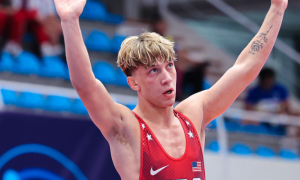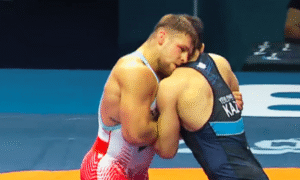Five Point Move is proud to host US Greco Roman National Team Head Coach Matt Lindland every week for “Coach Lindland’s Report.” For fans and wrestlers looking for insights regarding the US Greco National Team, we ask Coach Lindland some questions to get his take on training and upcoming competitions. If you have any questions you’d like us to ask going forward let us know via Facebook, Twitter, or through our Contact page.
Three weeks up, three weeks gone: Coach Lindland is finally back following the multinational pre-Olympic camp that began in Baku, Azerbaijan before being moved to Goygol, Azerbaijan for the second two weeks. We did get a chance to speak with Coach Lindland just as the US Greco Roman Team was arriving in Goygol but now he’s home and filled us in on some camp details, what the deal was with Bisek breaking the Moroccan, and how using heart-rate training has made a difference for the program.
5PM: Last time we talked you were heading into the second week of the three-week camp and weren’t 100% sure of the training plan for Goygol. So what did it consist of out there?
Coach Matt Lindland: For the last week, we had four live wrestling sessions, two technical sessions, two circuit days where we did a circuit workout with their team, and lots of recovery. The US team, we actually incorporated morning walks every day, so we were doing 30 minute walks before breakfast. We had breakfast and then practices were at 10:00am and 5:00pm. We did runs with them, as well.
5PM: How is your level of encouragement coming back from Azerbaijan and the last couple of weeks?
ML: Very encouraged. They’ve got such great wrestlers who we were able to be over there with and train with. And not just hang with them, but be right there with them. They’re some of the best guys in the world and it shows me how good of a team I’ve got. I’ve got a really good team. You know, I’ve mentioned these guys multiple times, I don’t think we’ve ever had an American team really buying into the fact that we can beat the rest of the world. I think there’s a lot of teams I’ve seen in the past, at least when I was around, they would say it, but I don’t know if they really believed it. You know, They want to beat the best guys in the world. But their actions showed they were content just being on the team. And I don’t get that impression from any one of these four guys, that they are at all content with being team members. I think they are all looking to get their medals in Rio.
5PM: I would assume that you and your four guys know who everybody else is, but is there a concentrated scouting process that goes on between now and when you leave for Brazil? You know, watching film and breaking down potential opposition?
ML: I know certain guys, in particular Jesse, doesn’t want to watch a lot of film on opponents. He wants to break down film on himself and see where he can improve. But as far as watching opponents, you know, give me the highlights and I’ll do what I’m going to do. We do have guys who will sit and break down their opponents, take notes. Ben has made it very clear to me that he wants to actually sit down during this next camp and go over opponents and watch some of the top guys to break them down a little more than he’s done by himself in the past. So we’re going to put some effort into that.
With this camp I have all the video of every single guy who’s qualified. I got it put into a program called Dartfish, which I was able to tag everything. I had some students help us out like, Here’s what you do: You stop it, you tag it and you say this is where red scored two points, this is where blue scored one or five points. They don’t need to know wrestling but they can look and see where the points are being scored and tag the video. And then we can go back in there and click to that point. Oh, it was a two-point takedown, it was an arm-drag and here was a gutwrench. We can add more layers of tagging onto this stuff with my staff and my coaches, but right now it expedites the viewing process. Yeah, you want to watch the pummeling but you might not want to watch six minutes of it. If you want to watch a lot of the scoring tactics and techniques as well, you can speed through that video process and technology has really helped us with that a lot. And right now, in my opinion, this is the best system and program out there to be able to scout video footage.
5PM: Video surfaced of Bisek going against the Moroccan…
ML: That day Andy had three matches, that was his third match and they were all eight-minute matches. They did two four-minute periods.
5PM: It was an entertaining video. What exactly is the back story?
ML: I don’t know if there was a back story. Like I said, it was Andy’s third match. He was wrestling matches that day. The night before we left the next day, so it was Friday, we left on Saturday and all we had was a run and a lift in the morning. But I think the back story was this is the way he trains, this is the way he pressures guys and stays on top of them. And this guy just didn’t want anymore. This guy comes out really hot, he wants to throw big headlocks and if you stay in good position and wrestle him past three minutes, past four minutes, the kid starts fading. I don’t know if there was much of a back story other than just the fact that here’s Andy, doing what he does, keeping pressure on his opponents until they don’t want to compete any more. And I think that is the way he trains, that is the way he competes. He doesn’t give an inch, he doesn’t give up position very easily. He stays in front of you, creates pressure on top of you, and there is some point where you get frustrated. You don’t want to be out there anymore with him. And that’s what happened, the kid just walked off the mat (laughs).
5PM: He sent him into a virtual padded room.
ML: Yeah. But that was pretty much all of his opponents that day. One of them was a 2012 Olympic bronze medalist, one of them was the guy that the Azerbaijanis are going to send as their 75 kg guy. And they all had a similar reaction but it wasn’t quite as dynamic as this one (laughs). But the story was the same. He frustrated these guys with constant pressure, stayed in their faces, and didn’t give them an inch to breathe.
5PM: Who is going to Rio aside from the four?
ML: The two training partners we’re taking are RaVaughn (Perkins), who will be warming up Jesse and he could also warm up Andy. And we’re going to take Joe (Rau), who can work with Ben and also Robby.
5PM: Camp starts again on Monday the 11th. You are going to taper them before building them back up again?
ML: Well right now this week, I’m just going to get them rested and recovered because over the weekend we’re going to do some vO2 max-lactate threshold testing just to see where they’re at and if I have to make any adjustments in our training conditioning-wise. Working the different zones and the heart rates. Coach Halvorson’s been bringing that kind of science into the program. We do a lot of heart rate training with our guys now. In 2014 Mark (Halvorson) introduced it, 2015 we really started to use it a lot more, the guys started getting comfortable with it. This year, it’s full-on. It’s like, Here’s your heart-rate monitor and put it on. Pretty much the only time we’re not doing heart-rate stuff is hard live wrestling. But we have experimented with it in live wrestling. That’s why I told you in 2014 we figured out something we feel may have made a difference in Andy’s performance as far as knowing exactly where his heart-rate needs to be before he steps on the mat and wearing that heart-rate monitor right up to when he does step on the mat, taking it off and pulling his straps up.
It’s been, like I said, the last couple of years we introduced it and got the guys comfortable with it. Now, they are fully engaged. Guys, we’re working base zone, we don’t want your heart rate over 150. Stay between 130 and 150 in that zone. Or, Hey we’re doing a circuit, here’s what we are going to work on, we’re going to get threshold training. I want your heart rate here and I want your recovery at 130. As soon as your heart rate is 130, we’re going to go again. So instead of using timers now, we’re actually being able to adjust the training specifically for each athlete because you could say, We’re going to recover 30 seconds or 40 seconds, but maybe at 30 seconds Robby’s heart rate doesn’t drop as much as Andy’s. So now we’re able to say, Okay, when your heart rate gets down to 130 we’re going to hit our second set. When your heart rate gets down to 130, we’re going to hit our third set. We’re going to use that to individualize training a lot more than just saying, Okay, let’s guess we’re all going to get down to 30 seconds or 40 seconds.
We’re still just breaking into it really, but we’re using it a lot. In the past, I think we were just using it for specific stuff but now we’re incorporating it into all of our training.
5PM: It’s a little bit of a different world than it was in 2000, huh?
Coach Matt Lindland: Yeah, it is. Science has really progressed a lot. I’m learning so much. Every day I get to learn something new, too, so I’m excited I’m growing along with these guys and able to help them perform better. Because I’m learning something new.
This last camp we’ve identified that we’re going to really focus on individualizing everybody’s plan. Everyone has specific objectives that they need to accomplish going forward and we have enough staff with Mark, Chris, Momir, myself, Muhammad, and Herb House here, we have enough coaches that we are able to identify and individualize everybody’s training plan from here until we leave for the Games. And the training partners that we are bringing in, their only role is to support the guy who is on the Olympic Team.
Be sure to follow Coach Matt Lindland on Facebook, Twitter, and his official blog for updates as we head closer to the Rio Olympics.


















